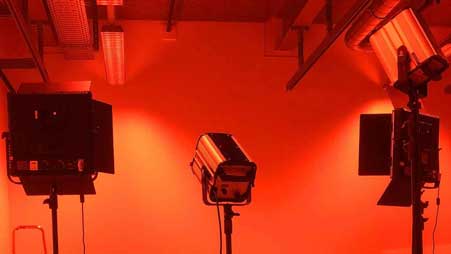LIGHTS, Camera, Action: How Cinematic Lighting Adds Drama and Impacts Movie Scenes
- Details
- Last Updated: Wednesday, 22 May 2024 15:04

The silver screen has captivated audiences for over a century with its capacity to transport them to imaginative realms and evoke a wide range of emotions. This phenomenon is a testament to the frequently overlooked craftsmanship of cinematic lighting, which acts as an invisible creator of a film's visual essence.
The practice of film lighting extends beyond simply illuminating a film set. The appropriate lighting configuration can elicit specific emotions, establish a connection with the audience, create a sense of drama, and highlight the underlying meaning of both the character and the scene.
Today, we will delve into the techniques employed in film lighting, which significantly impact the atmosphere and drama of our beloved big-screen flicks.
So Dramatic: Lumens and Backlighting
Lumens and backlighting are two crucial concepts in lighting. Comprehending these concepts is essential for developing a visually and emotionally compelling film.
The measurement of lumens quantifies the level of light emitted by a bulb, and the brightness of a lamp is directly proportional to its lumens. In other words, the higher the lumens, the brighter the light. The luminous intensity of a bulb can be measured in lumens. For example, a bulb with 1000 lumens emits more light than a bulb with 500 lumens. Regarding cinematic lighting, lumens are crucial in establishing the desired atmosphere. An illustration can be made by considering a scenario where a scene is set in a brightly illuminated field. In such a case, a light bulb with a higher lumen output would be necessary compared to a scene set in a poorly lit room.
The backlighting technique involves positioning the light source behind the subject, creating a halo effect surrounding the subject. This technique generates a sense of drama and accentuates the subject, thereby enhancing its prominence in relation to the background. Backlighting is a technique commonly employed in filmmaking to enhance the visual composition by adding depth and separating the subject from the background. Additionally, it establishes a specific atmosphere and enhances the intensity of a particular scene.
The introductory floor shot of the 1995 film Casino, featuring renowned actor Robert De Niro, showcases the application of backlighting in cinema. The shot depicts a well-lit casino floor, evoking a feeling of curiosity and exhilaration. The inclusion of backlighting in the scene enhances its visual composition by providing a sense of depth. This technique effectively illuminates the hidden and sinister aspects of the mafia, thereby evoking a feeling of impending doom, a world that’s close yet so far from the best online casino games in India that we know and love.
Ultimately, the inclusion of lumens and backlighting is crucial in the realm of cinematic lighting. The comprehension of these concepts can assist filmmakers in the creation of visually captivating and emotionally compelling films. The utilisation of backlighting has the capability to enhance the visual depth and dramatic effect of a scene. Similarly, manipulating lumens can effectively establish the desired atmosphere that aligns with the portrayed narrative.

The Drama of Harsh Lighting
The harsh light technique is a lighting setup that involves directing and intensifying smaller key light sources onto the subject while minimising the fill light. This approach is chosen deliberately to achieve a higher level of contrast in the shot than a conventional three-point lighting setup.
The use of lighting techniques, as demonstrated in various scenes from Fight Club or any film noir, directs the viewer's focus towards a particular element within the frame. This is achieved by strategically creating areas of darkness and shadow, resulting in a heightened sense of suspense and dramatic effects.
The technique of low-key lighting serves as a counterpart to the harsh light. The desired effect is achieved by positioning the light source beneath the subject. This arrangement creates comparable dark tones and shadows reminiscent of those seen in film shots. This lighting technique, commonly associated with characters such as Pennywise from the movie "It", has gained popularity for effectively portraying suspicious or antagonistic characters. The use of scary and ominous lighting effects helps to create an atmosphere that enhances the portrayal of these characters.

Key Lighting
The key light serves as the major illumination source for the subject in a scene and is the principal component of a three-point lighting arrangement. Key lights are crucial for establishing mood and ambience and accentuating the subject's characteristics and emotions.
Key lighting is achieved by placing the primary light source on one side of the person, directed towards their face, to provide a sense of depth and shadows, similar to the interrogation scene in Batman: The Dark Knight.

Chiaroscuro Is Cinema Gold for Drama
Chiaroscuro is a lighting technique highlighting the stark contrast between shadows and light inside a composition. It generates a theatrical atmosphere, enhances the complexity of your image, and intensifies the enigma.
The technique is frequently employed in film noirs and horror films to evoke a feeling of tension, peril, or mystery concealed inside the darkness. Chiaroscuro lighting is accomplished by filmmakers by using several light sources. This includes a primary key light positioned on one side and a fill light on the other side, which allows for the manipulation of shadow intensity.
Final Thoughts
Not all factors require visibility to possess significance, as evidenced by the discernible impact and atmospheres generated by the manipulation of lighting in the realm of filmmaking. The lights' location, colour, and intensity may significantly influence the appearance, allowing for a wide range of visual effects and narrative possibilities.
So, after reading our short explanation of lighting and its profound impact on cinematic drama, maybe you’ll notice it next time you’re off to the movies!




